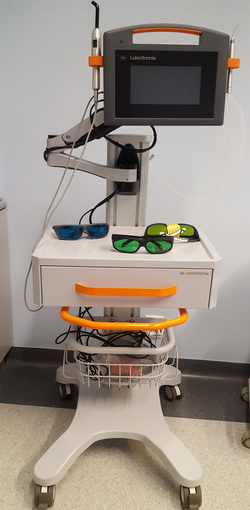Photoactive gum disinfection PAD
Paradontosis, inflammation of the gums both at its own teeth and implants, has the most common bacterial substrate. This disease usually has a chronic nature with periods of exacerbation and leniency, but it always leads to the gradual destruction and disappearance of bone tissue in the bleeding gum region. This is especially important for implants that are particularly vulnerable to bone atrophy due to lack of defensive mechanisms such as with their own teeth. Treatment for bleeding gums consists of removal of tartar above and subgingival
tartar , photoactive disinfection of the gums of the PAD and thorough instruction of the patient's oral hygiene to avoid recurrence of the problem in the future. The mere removal of stone deposits is often insufficient to chase the gums. The reason is bacteria that, despite the removal of the stone, remain in the gum pockets. Only the use of PAD allows the complete removal of bacteria from even the deepest pockets and allows the start of healing. The effect of photoactive disinfection consists in the use of photosensitism and then activateit with a laser with a wavelength of 635nm. Photosensitis particles stick to bacteria cells and, when activated with laser, produce a large amount of free radicals that destroy bacteria. What is the course of treatment? Here is a simplified scheme:
- A dentist or dental hygienist performs tartar removal, polishing of the tooth surface and possible fluoridation.
- It then injects toluidine blue into the spherary pockets and waits for 3 minutes to penetrate the photoulator into the cell walls of bacteria.
- After 3 minutes, a dentist or dental hygienist illuminates the laser gum pocket with photoulzan, destroying bacteria.
- The procedure ends the flushing of dead bacteria from the gum pockets. In case of major lesions, it is recommended to repeat the procedure after a period of 1 week.
Faqs:
- Is the photoactive disinfection procedure painful? – The procedure is completely non-invasive and painless. Laser light with a length of 635nm penetrates into the tissue without causing any damage, while photosensitizer – toluidine blue binds and damages only bacterial cells without violating its own tissues.
- Can photoactive disinfection be used to treat periodontitis? – one of the causes of periodontitis are pathogenic bacteria living in gingival pockets. Photoactive disinfection supports the treatment of periodontitis and bleeding gums by eliminating bacteria, but for permanent healing it is also necessary to have regular hygiene visits and skilful maintenance of oral hygiene .

